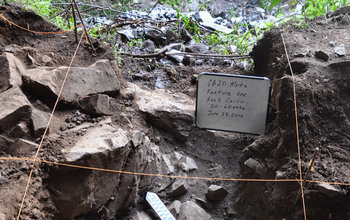Discovery in Ethiopia yields first ancient human genome sequence from Africa
 Credit and Larger Version |
October 8, 2015
Three years ago, a group of researchers found a cave in Ethiopia with a secret: it held the 4,500-year-old remains of a man, with his head resting on a rock pillow, his hands folded under his face, and stone flake tools surrounding him. The team named the man "Bayira," which means "firstborn" in the Gamo language, a common name in the region.
Today, in an article in the journal Science, that research team, supported in part by the National Science Foundation's Social, Behavioral and Economic Sciences directorate (SBE), revealed that there was another kind of treasure within the skeleton. Using DNA extracted from the bones, geneticists working with the researchers have been able to provide the first ancient human genome sequence from Africa. The genome has the potential to provide new clues about how ancient African populations lived and interacted with humans in other parts of the world./.../
No comments:
Post a Comment